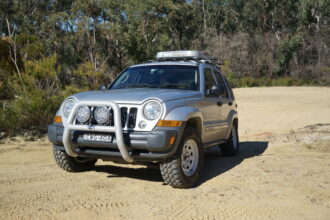Lose the liquorice strips with a 4X4-friendly 18” wheel option.
Ford’s latest edition of the seven-seat 4WD wagon is here, bringing some tweaks to the tuning and equipment of the Australian-designed Everest.
There’s big news with the wheels, in particular: A no-cost option for the luxury Titanium that allows you to swap the standard 20-inch package for 18” rims. Borrowed from the mid-range Trend, the off-road friendly change delivers a slightly taller sidewall which gives a definite benefit to off-road driving. To complete the package, Ford has revised the suspension and retuned the Everest’s stability control and terrain management systems.
NCO
It’s not just another driver aid acronym to get lost in: NCO means No-Cost Option. Pricing remains the same for the new version of the Titanium: $74,701 plus on-road costs. The pack has no impact on braked towing capacity (which remains at 3,000kg), or the Everest’s 800mm wading depth.
“The Everest has been awarded for its off-road capability, and many of our customers have and do take full advantage of this,” said Ford Australia President and CEO, Graeme Whickman, in a press release. “We’ve responded to this call, and we’re pleased to offer greater choice for Everest customers.”
The package offers 18×8.0-inch alloy wheels and Bridgestone Dueler H/T 265/60R18 rubber, including a full-size alloy spare. The standard Everest setup combines 20×8.5-inch alloy wheels with lower-profile 265/50 rubber. Look, we’re not about to tell you that this is a night-and-day change that revolutionises the Everest’s off-road performance… but that little extra sidewall does add a bit of puncture security and ride comfort.
We drove a pre-production version of the Everest (with the 18” package) from Perth up to Exmouth and back – avoiding highways and sticking to the dirt as much as possible – and we came out the other end puncture-free. That included testing out the Everest in some gnarly and rocky conditions in the Cape Range, as well as rattling across heaps of corrugations at high speed on our way up the coast and then heading inland to the Kennedy Range National Park on the way back.
OFF-ROAD
We next took on the rocks and sand of Lancelin and the extraordinary Pinnacles tourist drive, where the Everest reminded us why it’s such a good base vehicle. The expert local tuning of the modified Ranger T6 platform it’s based on, including coils and a Watt’s link, behaves really well in Aussie conditions… especially those endless corrugations. That’s complemented by the Terrain Management System’s tuning – which in combination with low-range gearing allows the Everest to plough on through a variety of harsh off-road conditions. This includes the deep, soft sand we had a play in during our Coral Coast exploration.
While the Everest’s 3.2-litre inline five-cylinder turbo-diesel engine sounds rough and ready, it’s always willing and able and works well with the standard six-speed auto.
Not everything about the Everest blows us away. At 80 litres, the fuel tank is a bit undersized for true Outback work; and there’s some compromises in the cabin caused by its truck base – like the lack of a reach-adjustable steering wheel. And why Ford, if you’re going to offer an off-road option, why deliver it with highway tyres rather than all-terrain tyres? Bit odd, we reckon, because the Everest would be an even better unit off-road with some quality off-road biased rubber.
But the Everest is a good jigger for sure and better than the likes of other ute-based 4X4 wagons like the Toyota Fortuner. So it’s good to see them starting to pop up amongst the fleets of Toyotas preferred by grey nomads. Having said that, the Toyota Prado (which Ford insists the Everest is a match for) is a tough test. Unsealed 4X4 has previously judged it to be a better off-roader, and it does come with significantly more fuel capacity.
SPEC
There’s another question here too: Why bother with the Titanium… when you can have the Everest Trend with the same wheel and tyre package and off-road performance as the Titanium, for $16,000 less?
Well, it’s in the equipment, especially the safety gear: Blind spot monitoring, active park assist and tyre pressure monitoring are all exclusives.
Extra luxury gear includes leather seats (except row three) and leather-wrapped gearshift; ambient lighting; illuminated front scuff plates; a powered panoramic sunroof; eight-way powered and heated front seat adjustment; power folding third row; chromed running boards; HiD headlights; and LED daytime running lamps. You know what they say… it’s your money so it’s your choice.
Watt. What?
In place of the leaf springs the Ranger uses as rear suspension, the Everest keeps a live axle but uses a Watts-Linkage for suspension geometry. Rather than Panhard rods that other vehicles use in the rear, the Watts-Linkage uses two big connections that run in line with the axle housings and connect at the rear of the diff pumpkin. This gives limited off-road wheel travel compared to other setups, but it does have great on-road compliance. Land Rover’s Discovery 2, from 1998 to 2006, ran a similar setup in the rear.
JUST THE SPECS: 2018 Ford Everest TITANIUM
| Engine: | 3.2-litre, five-cylinder turbo-diesel. 143kW @ 3,000rpm. 470Nm @ 1,750-2,500rpm. |
| Transmission: | Six-speed automatic gearbox, full-time 4WD with two-speed transfer case and locking rear differential. |
| Dimensions: | 4,892mm long, 1,860mm wide, 1,837mm high. 2,850mm wheelbase. |
| Ground clearance: | 225mm. 29.5º approach, 21.5º rampover, 25º departure angles. |
| Suspension: | Independent front, Watts-Linkage live rear. |
| Fuel capacity: | 80 litres. |
| Weights: | 2,492kg kerb, 3,100kg GVM. 606kg payload. |
| Towing: | 3,000kg towing capacity; 5,800kg GCM. |
| RRP: | $74,701, plus on-road costs. |









